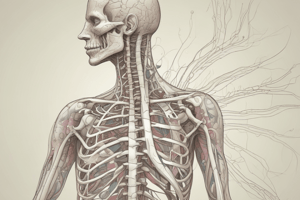Podcast
Questions and Answers
Which spinal nerve plexus originates from the ventral rami L1 to L4?
Which spinal nerve plexus originates from the ventral rami L1 to L4?
- Brachial Plexus
- Lumbar Plexus (correct)
- Sacral Plexus
- Cervical Plexus
What is a potential consequence of damage to the Femoral nerve?
What is a potential consequence of damage to the Femoral nerve?
- Inability to extend the leg and flex the hip (correct)
- Inability to adduct the thigh
- Loss of wrist movement
- Loss of sensation in the lower back
Which body area is served by the Obturator nerve?
Which body area is served by the Obturator nerve?
- Skin of the anteromedial leg
- Lateral thigh muscles
- Adductor muscles of the medial thigh (correct)
- Muscles of the abdominal wall
Which of the following is NOT a function of the Femoral nerve?
Which of the following is NOT a function of the Femoral nerve?
What might a patient experience if the Obturator nerve is damaged?
What might a patient experience if the Obturator nerve is damaged?
What is the primary function of mixed nerves?
What is the primary function of mixed nerves?
Which connective tissue sheath surrounds individual neuron fibers?
Which connective tissue sheath surrounds individual neuron fibers?
How do sensory (afferent) nerves function within the nervous system?
How do sensory (afferent) nerves function within the nervous system?
Which connective tissue layer binds groups of fascicles in a nerve?
Which connective tissue layer binds groups of fascicles in a nerve?
What is one function of cranial nerves?
What is one function of cranial nerves?
Which cranial nerve is responsible for the sense of smell?
Which cranial nerve is responsible for the sense of smell?
What role does perineurium play in nerve structure?
What role does perineurium play in nerve structure?
Which of the following pairs of cranial nerves extend to thoracic and abdominal cavities?
Which of the following pairs of cranial nerves extend to thoracic and abdominal cavities?
What is the effect of the sympathetic division on adipose tissue?
What is the effect of the sympathetic division on adipose tissue?
How does the sympathetic division affect blood vessels in the skin and viscera?
How does the sympathetic division affect blood vessels in the skin and viscera?
What is a parasympathetic effect on the digestive system?
What is a parasympathetic effect on the digestive system?
What effect does the sympathetic division have on cellular metabolism?
What effect does the sympathetic division have on cellular metabolism?
What is the effect of the sympathetic division on the arrector pili muscles?
What is the effect of the sympathetic division on the arrector pili muscles?
What is the primary function of the cell body in a neuron?
What is the primary function of the cell body in a neuron?
Which part of the neuron is responsible for conducting impulses towards the cell body?
Which part of the neuron is responsible for conducting impulses towards the cell body?
What defines the synaptic cleft in neuronal communication?
What defines the synaptic cleft in neuronal communication?
What is the role of Schwann cells in the peripheral nervous system?
What is the role of Schwann cells in the peripheral nervous system?
How do myelin sheaths affect nerve impulse transmission?
How do myelin sheaths affect nerve impulse transmission?
What is a primary characteristic of oligodendrocytes in the central nervous system?
What is a primary characteristic of oligodendrocytes in the central nervous system?
What is the function of axon terminals?
What is the function of axon terminals?
What is the primary function of the peripheral nervous system (PNS)?
What is the primary function of the peripheral nervous system (PNS)?
Which structure in a neuron helps maintain the cell's shape?
Which structure in a neuron helps maintain the cell's shape?
Which type of nervous system division carries information to the central nervous system?
Which type of nervous system division carries information to the central nervous system?
Which subdivision of the motor (efferent) division controls voluntary movements?
Which subdivision of the motor (efferent) division controls voluntary movements?
What distinguishes neurons from supporting cells (neuroglia)?
What distinguishes neurons from supporting cells (neuroglia)?
What is the role of visceral sensory (afferent) fibers?
What is the role of visceral sensory (afferent) fibers?
Which of the following is a function of neuroglia in the CNS?
Which of the following is a function of neuroglia in the CNS?
Which system further divides into sympathetic and parasympathetic systems?
Which system further divides into sympathetic and parasympathetic systems?
What characterizes the supporting cells called neuroglia?
What characterizes the supporting cells called neuroglia?
Flashcards are hidden until you start studying
Study Notes
Peripheral Nervous System (PNS)
- The PNS consists of nerves that extend from the brain and spinal cord, serving as communication channels between sensory organs, the brain and spinal cord, and muscles/glands.
- Spinal nerves carry impulses to and from the spinal cord.
- Cranial nerves carry impulses to and from the brain.
Sensory (Afferent) Division
- This division carries information to the central nervous system.
- Somatic sensory (afferent) fibers transmit signals from skin, skeletal muscles, and joints.
- Visceral sensory (afferent) fibers convey information from internal organs.
Motor (Efferent) Division
- This division carries impulses away from the central nervous system to effector organs (muscles and glands).
- Somatic Nervous System:
- Controls skeletal muscles voluntarily.
- Autonomic Nervous System:
- Controls smooth and cardiac muscles, and glands involuntarily.
- Further divided into the sympathetic and parasympathetic nervous systems.
Nervous Tissue: Support Cells
- Support cells in the CNS are collectively called neuroglia.
- These cells provide support, insulation, and protection for neurons.
Nervous Tissue: Neurons
- The basic functional unit of the nervous system.
- Neurons are specialized cells that transmit nerve impulses.
- Cell Body: The metabolic center of the neuron, containing the nucleus and other organelles.
- Processes (Fibers):
- Dendrites: Receive impulses and carry them towards the cell body.
- Axons: Carry impulses away from the cell body.
- Axon Terminals: Contain neurotransmitters, released at synapses.
- Synaptic Cleft: The gap between axon terminals and the next neuron.
- Synapse: The functional junction between neurons where nerve impulses are transmitted.
Myelin Sheaths
- Myelin is a white, fatty material that covers axons, enhancing the speed of nerve impulse transmission.
- Schwann Cells: Produce myelin sheaths in the PNS.
- Neurilemma: The outer layer of the Schwann cell.
- Nodes of Ranvier: Gaps in the myelin sheath along the axon.
- Oligodendrocytes: Produce myelin sheaths around axons in the CNS, lacking a neurilemma.
Peripheral Nervous System (PNS)
- The PNS consists of nerves and ganglia outside the CNS.
Structure of a Nerve
- Nerves are bundles of neuron fibers found outside the CNS, with protective connective tissue coverings.
- Endoneurium: Surrounds each individual fiber.
- Perineurium: Wraps groups of fibers bound into a fascicle.
- Epineurium: Binds groups of fascicles together.
- Mixed Nerves: Contain both sensory and motor fibers.
- Sensory (Afferent) Nerves: Carry impulses toward the CNS.
- Motor (Efferent) Nerves: Carry impulses away from the CNS.
Cranial Nerves
- There are 12 pairs of cranial nerves primarily serving the head and neck, with the vagus nerves extending into the thoracic and abdominal cavities.
Spinal Nerve Plexuses
- Spinal nerves form networks called plexuses, which serve specific regions of the body.
- Groups of spinal nerves can be damaged, affecting specific areas of the body.
- Cervical Plexus (C1-C5)
- Innervates the neck, shoulders, and diaphragm.
- Brachial Plexus (C5-T1)
- Innervates the upper limbs.
- Lumbar Plexus (L1-L4):
- Innervates the lower abdomen, anterior and medial thigh muscles, and skin of the anteromedial leg and thigh.
- Sacral Plexus (L4-S5)
- Innervates the buttocks, posterior thigh, and lower leg muscles.
Autonomic Nervous System
- The autonomic nervous system regulates involuntary functions, including heart rate, digestion, and breathing.
- Sympathetic Division:
- Prepares the body for "fight or flight" responses.
- Increases heart rate, breathing rate, and blood pressure.
- Dilates pupils.
- Decreases digestive activity.
- Parasympathetic Division:
- Promotes "rest and digest" responses.
- Decreases heart rate, breathing rate, and blood pressure.
- Constricts pupils.
- Increases digestive activity.
Studying That Suits You
Use AI to generate personalized quizzes and flashcards to suit your learning preferences.





